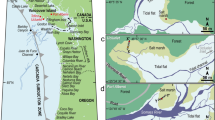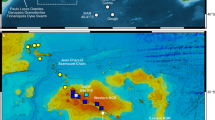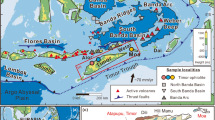Abstract
THE deep sea drilling project (DSDP) Leg 17 has covered the area of the Central-Pacific Basin south of the Mid-Pacific Mountains and east of the Marshall Islands. Since this region belongs to the magnetic quiet zone, no definite ages of oceanic crust could be assigned. Results of drilling at Site 166 (3°45.7′N, 175°4.8′W) and at site 167 on Magellan Rise (7°4.1′N, 176°49.5′W) have given estimates of crustal ages of about 120 and 135 Myr respectively from the basement fossils, which suggests that ages increase northward on this set1. Furthermore, the parallelism of linear bathymetric features around site 167 to the magnetic and bathymetric trends around site 166 has been interpreted by Winterer1 to mean that they belong to the same spreading ridge system with an average spreading rate of 2–4 cm yr−1 for the crust between the two sites. Since sites 169 and 170 are located to the north-west of the sites 166 and 167 in the magnetic quiet zone, they were expected to give older ages, probably Jurassic, from the extrapolation of the trend stated above and by referring to the time scale of magnetic reversals2. It has been revealed, however, that at site 169 (10°40.2′N, 173°3.0′E) the oldest sediment recovered yields Albian age (100–104 Myr), which overlies basalt. At this site, about 8 m of diabase sill was drilled, which intruded Turonian (87–95 Myr) or Cenomanian (95–100 Myr) sediments3. At site 170 (11°48.0′N, 177°37.0′E), the oldest sediment overlied the basalt is also of Albian age4. These ages are much younger than those expected from ages obtained at sites 166 and 167, which may reflect the different history of the ocean floor from those at sites 166 and 167. To clarify this point, two igneous rocks were dated by 40Ar/39Ar method. Details of experimental procedures are described elsewhere5.
This is a preview of subscription content, access via your institution
Access options
Subscribe to this journal
Receive 51 print issues and online access
$199.00 per year
only $3.90 per issue
Buy this article
- Purchase on Springer Link
- Instant access to full article PDF
Prices may be subject to local taxes which are calculated during checkout
Similar content being viewed by others
References
Winterer, E. L. Initial Reports of DSDP 17, 5–15 (U.S. Government Printing Office, Washington, 1973).
Larson, R. L. & Hilde, T. W. C. J. geophys. Res. 80, 2586–2594 (1975).
DSDP, The Shipboard Scientific Party, Initial Reports of DSDP 17, 247–262 (U.S. Government Printing Office, Washington, 1973).
DSDP, The Shipboard Scientific Party, Initial Reports of DSDP 17, 263–281 (U.S. Government Printing Office, Washington, 1973).
Saito, K. & Ozima, M. Earth planet. Sci. Lett. 33, 353–369 (1977).
Bass, M. N., Moberley, R., Rhodes, J. M., Shih, C. & Church, S. E. Initial Reports of DSDP 17, 429–503 (U.S. Government Printing Office, Washington, 1973).
Scientific Staff, Leg 37, DSDP, Geotimes 19, 16–18 (1974); Scientific Staff, Leg 46, DSDP, Geotimes 21, 21–23 (1976).
Author information
Authors and Affiliations
Rights and permissions
About this article
Cite this article
KANEOKA, I., OZIMA, M. 40Ar/39Ar ages of a diabase sill and a basalt in the Central-Pacific Basin. Nature 268, 132–133 (1977). https://doi.org/10.1038/268132a0
Received:
Accepted:
Issue Date:
DOI: https://doi.org/10.1038/268132a0
Comments
By submitting a comment you agree to abide by our Terms and Community Guidelines. If you find something abusive or that does not comply with our terms or guidelines please flag it as inappropriate.



